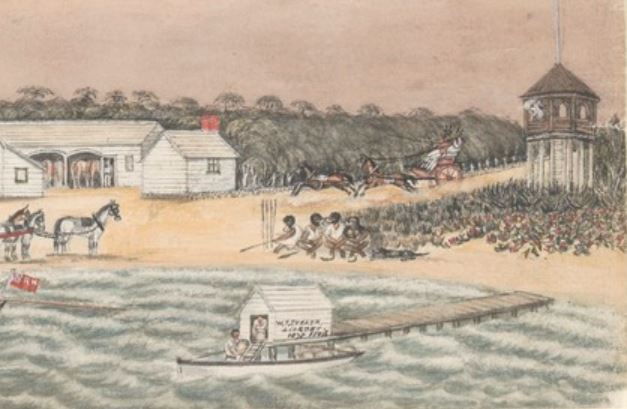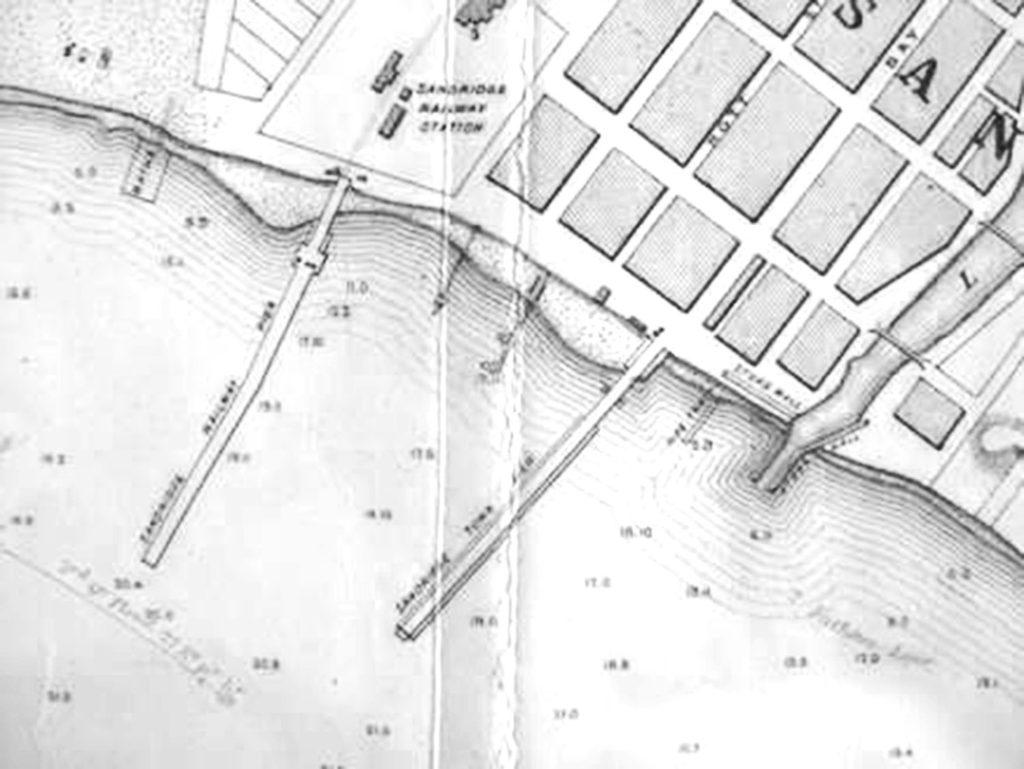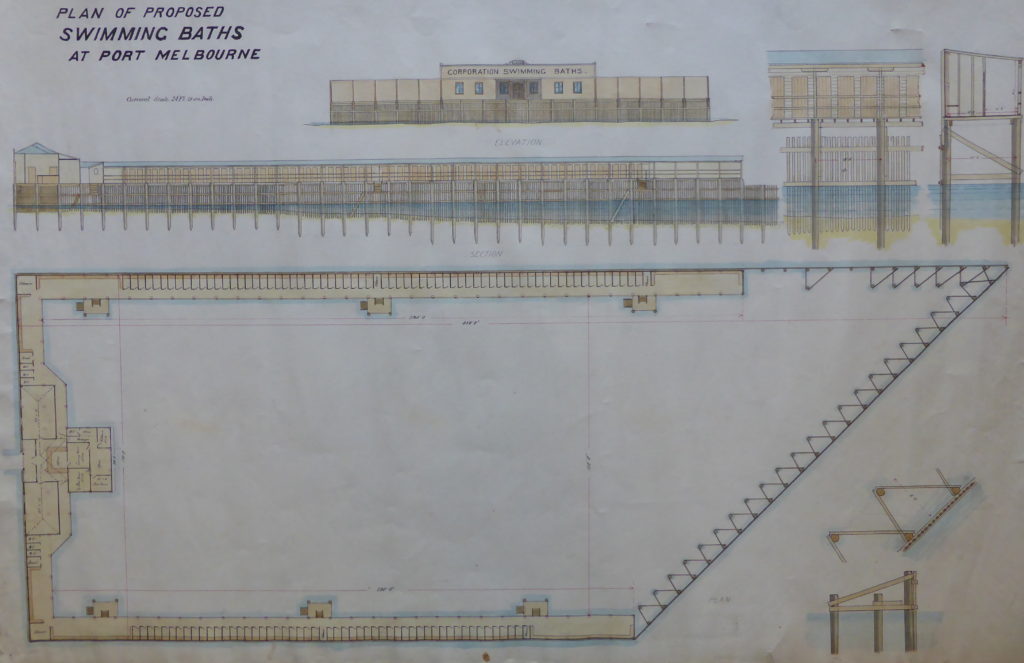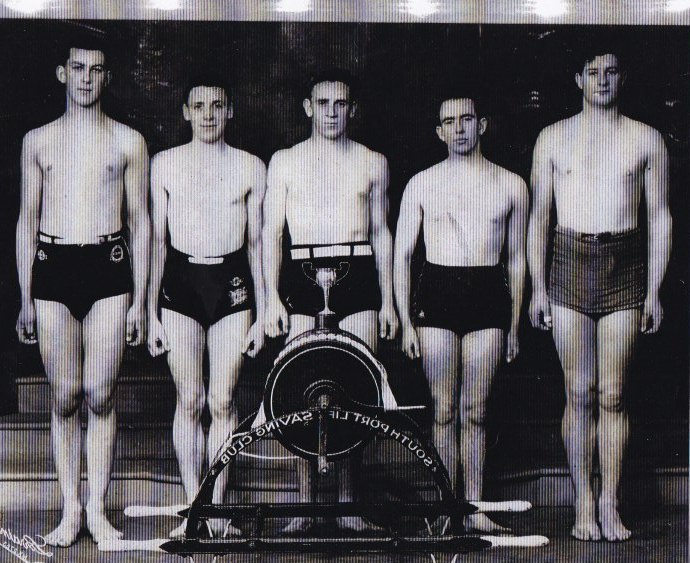Sea Baths in Sandridge and Port Melbourne
Pier Hotel Baths
Sandridge had only been settled a few years when the first sea bath was opened as one of the many facilities offered by Wilbraham Liardet at the Pier Hotel. In 1843 he advertised in the Port Phillip Patriot that there was a spacious and convenient swimming bath, and shower, warm bath if required. The bathing facility is clearly shown in the painting of the Pier Hotel that Wilbraham did in 1874.

Anyone wishing to bathe could walk out on the small jetty to the little bath house, change to appropriate clothes and plunge into the water from the open doorway. Wilbraham himself, in a letter to the Argus offered advice on how the bather should best proceed: the bad practice and timid way of walking into water up to the hips, and then dipping the head two or three times … does more harm than good – rather when they go to bathe should plunge head foremost into the water. He particularly urged readers to do this in the cold weather. This early bathing jetty may not have survived long. Many such structures soon succumbed to the winter storms.
The Sandridge Baths
In 1854, at the Chusan Hotel, the Sandridge Sea Bathing association was formed and in December of that year they advertised in the Argus that a Gentlemen’s Bath was now open. Their location near the mouth of the Lagoon can be seen on the 1878 map of Sandridge.

The following advertisement appeared in 1861 and is a clear description.
THE SANDRIDGE BATHS
Mr. Stubbs will SELL by PRIVATE CONTRACT or public auction.The above baths, so well known, situated to the left of Hobson’s Bay Railway Station and just past the Victorian Sugar Works. The buildings and contents comprise two W.B. cottages, refreshment room. Pier running out 200 feet seaward to the enclosed and ladies baths, the enclosed bath has 20 boxes for bathers, with ladders, etc. The place runs thence about 100 feet to the deep water baths, which contain 30 boxes. There is a good diving board and every convenience and all in first rate order; two boats with oars, pulleys, etc. The Borough and its People, page 208
Stubbs baths, as they were generally called, fell into disrepair and by 1875 were no longer in use.
Railway Baths
In 1855 new baths were built near Railway Pier between Stokes and Nott streets and officially know as the Railway Baths but also referred to as Dardanelli’s Bathing Ship or just the Bathing Ship. Like a number of other sea baths around Port Phillip bay, they consisted of a ship moored at the end of a jetty with a wooden fence enclosing the bathing area. The enclosing fence was intended to protect from shark attack as well as providing privacy. People were very fearful of shark attacks in Port Philip Bay. Although sharks were a not uncommon sight, only one death was reported and that not until 1876 off Emerald Hill beach. There was never any shortage of derelict ships that could be used in sea baths. This one was the barge The Premier that became a point of contention because some ship owners thought it an unsightly object for passengers arriving at Railway Pier. By 1878 the most of the construction was demolished.
Watson’s Baths: Hobson’s Bay Railway Baths
These baths were built by the Hobson’s Bay Railway Company in 1860 at a cost of £3,500. Bruce Bennett writes: Special trains brought patrons to the Hobson’s Bay Sea Bathing Company Baths in 1860 with a return rail fare to the very commodious baths of 1 shilling. These baths were run by a well known diver, Thomas Watson from 1881 to 1906 and hence their popular name of Watson’s baths. They too fell into disrepair and were largely demolished in 1908.
Proposed Baths 1911
Although the whole foreshore was opened to bathing in 1911, plans were drawn up for new sea baths. A copy of these plans is part of the Port Melbourne Historical and Preservation Society Collection.

The sign over the entrance reads: Corporation Swimming Baths. In these plans the changing facilities were to be located at the entrance, there was to be a very substantial picket fence enclosing two sides of the baths and what appears to be a mesh fence across the seaward end. A note on the plans simply states that construction did not go ahead due to lack of funds but by then swimming on the beach without the protection of baths was a common practice.
A West Beach Swimming Club with 350 members built their own club house on the beach in 1912 and the Port Melbourne Life Saving Club was founded in 1913.

The great era of the sea baths in Port Melbourne had come to an end, open beach swimming for both men and women had become the normal experience for the residents of Port Melbourne.
Margaret Bride, October 2019
Please note: In using the image of W F E Liardet’s Pier Hotel, the State Library of Victoria advises that the subject of this work may include images and names of deceased people; it may also include words and descriptive terms that may be offensive to Indigenous Australians. This work is presented as part of the record of the past; contemporary users should interpret the work within that context.
References
Sea Baths of Victoria, Bruce Bennett, 2013
The Borough and its People, Margaret and Graham Bride, 2013
